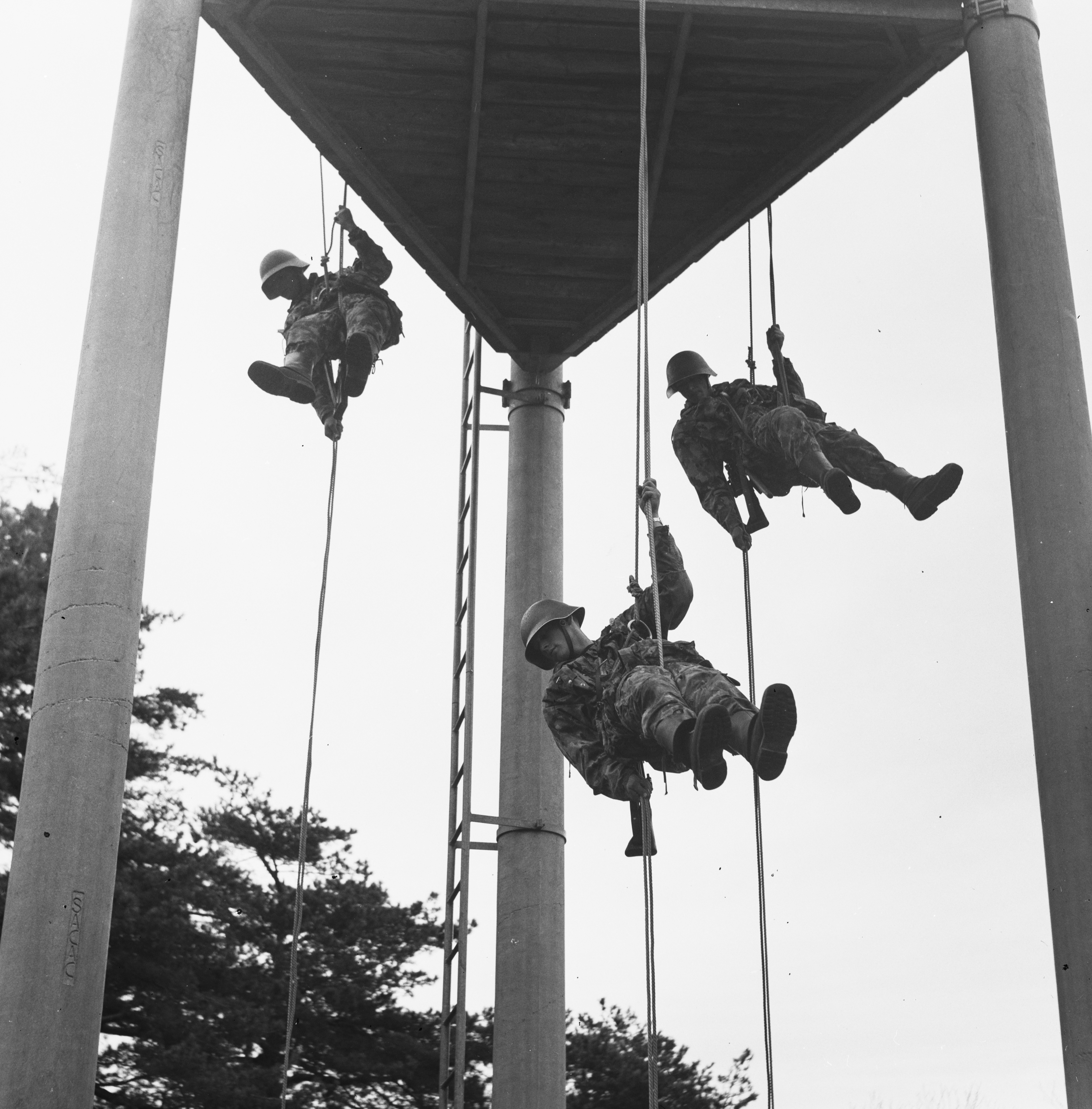|
Abseiling
Abseiling ( ; ), also known as rappelling ( ; ), is the controlled descent of a steep slope, such as a rock face, by moving down a rope. When abseiling the person descending controls their own movement down the rope, in contrast to lowering off in which the rope attached to the person descending is paid out by their belayer. This technique is used by climbers, mountaineers, cavers, canyoners, search and rescue and rope access technicians to descend cliffs or slopes when they are too steep and/or dangerous to descend without protection. Many climbers use this technique to protect established anchors from damage. Rope access technicians also use this as a method to access difficult-to-reach areas from above for various industrial applications like maintenance, construction, inspection and welding. To descend safely, abseilers use a variety of techniques to increase the friction on the rope to the point where it can be controlled comfortably. These techniques range f ... [...More Info...] [...Related Items...] OR: [Wikipedia] [Google] [Baidu] |
Dülfersitz
The Dülfersitz (named after its inventor, mountaineer Hans Dülfer), also known as body rappel is a classical, or non-mechanical abseiling technique, used in rock climbing and mountaineering. It is not used frequently any more, since the introduction of belay devices. In the Dülfersitz, the rope is wound around the body, and the speed of descent is controlled using the friction of the rope against the body. The advantages of the Dülfersitz are that one can descend without a climbing harness or belay device, and because the rope is not kinked or subjected to concentrated forces, it does not experience as much wear. The major disadvantage of this method is that intense heat is generated by the friction on the shoulder, neck and thigh, which can be painful, and can damage clothing. Abseiling by means of the Dülfersitz *The doubled rope is passed between the legs *The rope is passed behind one thigh *Crossing the chest, the rope is taken to the opposite shoulder *From the sho ... [...More Info...] [...Related Items...] OR: [Wikipedia] [Google] [Baidu] |
Rope
A rope is a group of yarns, plies, fibres, or strands that are twisted or braided together into a larger and stronger form. Ropes have tensile strength and so can be used for dragging and lifting. Rope is thicker and stronger than similarly constructed cord, string, and twine. Construction Rope may be constructed of any long, stringy, fibrous material, but generally is constructed of certain natural or synthetic fibres. Synthetic fibre ropes are significantly stronger than their natural fibre counterparts, they have a higher tensile strength, they are more resistant to rotting than ropes created from natural fibres, and they can be made to float on water. But synthetic ropes also possess certain disadvantages, including slipperiness, and some can be damaged more easily by UV light. Common natural fibres for rope are Manila hemp, hemp, linen, cotton, coir, jute, straw, and sisal. Synthetic fibres in use for rope-making include polypropylene, nylon, polyesters ... [...More Info...] [...Related Items...] OR: [Wikipedia] [Google] [Baidu] |
Autoblock Knot
An autoblock (or autobloc or "third hand") is a rope device used in climbing and caving for both rappelling (downward) and ascending (upward). While rappelling, it slides freely down the rope when pushed downward by the hand, allowing a controlled descent, but jams in the event of a sudden drop or loss of control, stopping the descent. This prevents uncontrolled falls in the event of an accident in which the abseiler loses control of the rope. For ascending, it likewise can be pushed up the rope manually when unweighted, but jams and holds when weighted by the body. It is made using a friction hitch around the rope, connected by a carabiner to the climber's harness, and may be combined with other climbing equipment for further safety. For instance, it is typically used as a backup while rappelling using a tube belay device. The term autoblock is also used for a specific type of friction hitch, which is also known as a French prusik or Machard knot, named after its invento ... [...More Info...] [...Related Items...] OR: [Wikipedia] [Google] [Baidu] |
Caving
Caving – also known as spelunking in the United States and Canada and potholing in the United Kingdom and Ireland – is the recreational pastime of exploring wild cave systems (as distinguished from show caves). In contrast, speleology is the scientific study of caves and the cave environment.Caving in New Zealand (from Te Ara: The Encyclopedia of New Zealand, Accessed 2012-11.) The challenges involved in caving vary according to the cave being visited; in addition to the total absence of light beyond the entrance, negotiating pitches, squeezes, ... [...More Info...] [...Related Items...] OR: [Wikipedia] [Google] [Baidu] |
Static Rope
A static rope is a low-elongation rope that is designed to stretch minimally when placed under load, typically less than 5%. In contrast, a dynamic rope is designed to stretch up to 40%. Static ropes have a wide variety of uses, for instance in fire rescue operations and caving. Static ropes have some applications in climbing, such as hauling gear, though lead climbing is always done with a dynamic rope, since a fall on a static rope is stopped too quickly and may lead to serious injury. Abseiling, however, is best done with a static rope or with a dynamic rope with low elasticity. See also *Kernmantle rope Kernmantle rope () is rope constructed with its interior core protected by a woven exterior sheath designed to optimize strength, durability, and flexibility. The core fibers provide the tensile strength of the rope, while the sheath protects the ... References * Climbing equipment Ropes {{Climbing-stub ... [...More Info...] [...Related Items...] OR: [Wikipedia] [Google] [Baidu] |
Dynamic Rope A dynamic rope is a specially constructed, somewhat elastic rope used primarily in rock climbing, ice climbing, and mountaineering. This elasticit |






